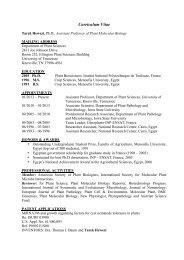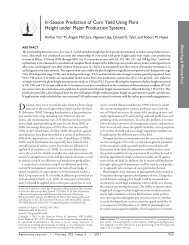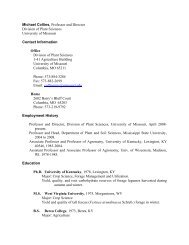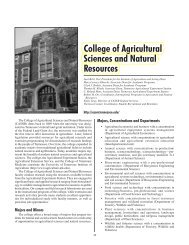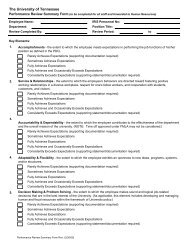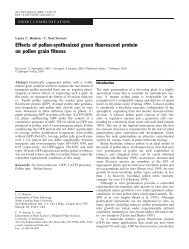CATEGORIES OF FORAGE CROPS - Department of Plant Sciences
CATEGORIES OF FORAGE CROPS - Department of Plant Sciences
CATEGORIES OF FORAGE CROPS - Department of Plant Sciences
Create successful ePaper yourself
Turn your PDF publications into a flip-book with our unique Google optimized e-Paper software.
Major Uses: Pasture, hay. Develops stems several weeks earlier than other warm season<br />
grasses so may become stemmy and unpalatable early in summer. Improved<br />
varieties have higher yields and nutritive quality.<br />
Establishment: Slow seedling establishment. Seed should be planted at 5 to 6 lb/A pure live<br />
seed in April-May.<br />
Fertilization: Very responsive to nitrogen.<br />
Production:<br />
Management:<br />
Late May-July.<br />
Should be stocked heavily and rotationally stocked with 4 to 6 weeks rest<br />
between grazings to maintain quality and stands.<br />
COOL-SEASON PERENNIAL GRASSES<br />
Kentucky Bluegrass (Poa pratensis)<br />
Origin: Europe<br />
Description: Perennial. Rhizomes produce a dense sod. Grows 1 to 3 feet tall.<br />
Major Uses: Pasture, limited use for hay. High nutritive value.<br />
Establishment: Seed are planted at 10 to 15 lb/A in August-September, or sometimes in<br />
February-March.<br />
Fertilization: Kentucky bluegrass will survive under low fertility, but is not highly productive<br />
unless well fertilized or grown with a legume.<br />
Production: April-October, limited in July and August.<br />
Management: Kentucky bluegrass tolerates close and frequent grazing better than many<br />
grasses. Grazing to a height <strong>of</strong> 1 to 2 inches favors productivity and maintains a<br />
dense sod. Bluegrass pasture is much more productive when clover is grown<br />
with it.<br />
Matuagrass (Bromus willdenowii)<br />
Origin: Argentina<br />
Description: Short-lived perennial or natural reseeding annual bunchgrass. Grows 2 to 4 feet<br />
tall.<br />
Major Use: Pasture. High nutritive quality. Good winter production.<br />
Establishment: Seed are planted in September at 25 to 30 lb/A, not deeper than 1/4-inch.<br />
Seedling vigor and growth are exceptional.<br />
Fertilization: High fertility requirement.<br />
Production: November to May or June.<br />
Management: Will not perenniate under close continuous grazing. Must be rotationally<br />
stocked to maintain stands.<br />
Orchardgrass (Dactylis glomerata)<br />
Origin: Europe<br />
Description: Perennial bunchgrass. Grows 2 to 3 feet tall.<br />
Major Uses: Pasture, hay. Forage quality is high under good management.<br />
Establishment: Seed should be planted in September at 15 to 20 lb/A, preferably with a legume.<br />
<strong>Plant</strong>ings are sometimes made in early spring.<br />
Fertilization: Requires higher fertility than tall fescue. Responds well to nitrogen.<br />
Production: March-June or July; production during September-November is much less than<br />
58



